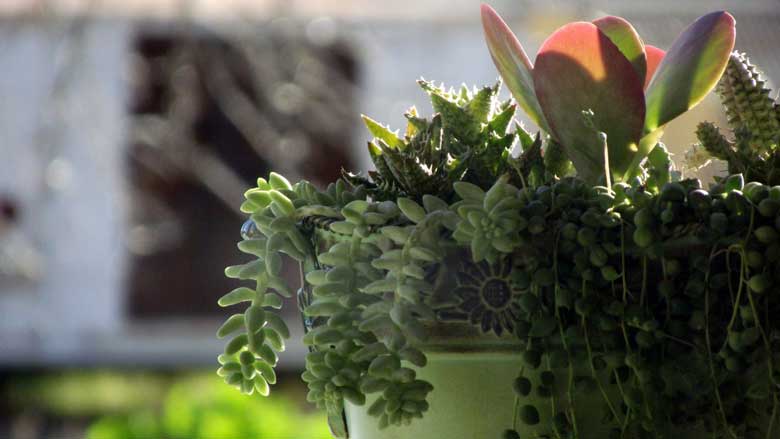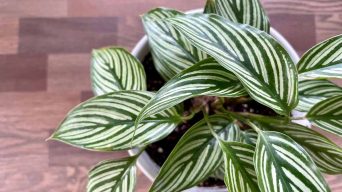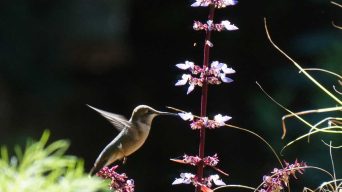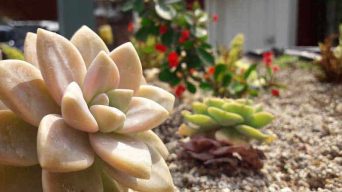Are succulents indoor or outdoor plants? This is a question that many people have, and the answer is not always clear.
Succulents can be grown indoors or outdoors, depending on the climate and environment where they are located.
Some succulents are better suited for indoor environments, and others are better suited for outdoor environments.
Here I will discuss the pros and cons of keeping succulents indoors vs. outdoors.
We will also discuss the best growing conditions for succulents and give you some tips on how to care for them.
Indoor vs. Outdoor Succulents
Succulents, although they have very particular needs, are versatile plants that can be grown in various environments.
They are commonly found indoors, but they can also be grown outdoors in the right climate.
There are a few factors to consider when deciding whether succulents are best grown indoors or outdoors.
The first factor is climate. Succulents are native to warm temperatures, and they do not do well in cold weather.
If you live in a colder climate, it is best to grow succulents indoors.
Another factor to consider is light exposure. Most succulents need plenty of bright light, but some can tolerate lower light levels.
If you cannot provide your succulents with enough sunlight, then it is best to grow them outdoors.
Humidity is another essential factor to consider when deciding where to grow succulents.
Succulents do not like high humidity. They prefer dry environments, and too much humidity can cause them to rot.
Another consideration is water availability. Succulents come from dry climates where rain is infrequent.
They do not like to be constantly wet and can quickly rot if they are overwatered. So, in climates where it rains frequently, succulents are better grown indoors.
Also, consider the size of your succulents.
Some succulents get very large and need a lot of space to grow, while others stay small.
If you have limited space indoors, it is best to choose smaller types of succulents.
The Pros of Growing Succulents Indoors
There are many reasons to grow succulents indoors.
Here are some of the benefits:
- Indoor growing conditions can be controlled, which is helpful for succulents that need specific light or humidity levels.
- Succulents are often easier to care for than other houseplants. They do not require a lot of water and can tolerate dry conditions.
- Indoor growing allows you to have succulents year-round, regardless of outside weather.
- Succulents are a great way to add life and color to an indoor space.
The Cons of Growing Succulents Indoors
While there are many benefits to growing indoor succulents, there are also a few drawbacks:
- Indoor growing can be challenging if you do not have the right environment for your succulents.
- Some succulents can get very large and take up a lot of space.
- Indoor succulent plants may not get enough sunlight, leading to them becoming leggy or losing their color.
- Succulents can be susceptible to pests and diseases, which can be challenging to treat in an indoor setting.
The Pros of Growing Succulents Outdoors
There are several reasons to grow succulents outdoors.
Here are some of the advantages:
- Many succulents grow very large outdoors, so they are great for adding visual interest to a landscape.
- Many succulents are native to hot, sunny climates, so they are well-suited for growing outdoors in those climates.
- Outdoor space allows succulents to get the direct sunlight they need to stay healthy.
- Outdoor succulents can have more space to grow, unlike succulents grown indoors.
- Outdoor succulents are exposed to natural rainfall, which helps them stay hydrated.
The Cons of Growing Succulents Outdoors
There are also a few disadvantages to growing succulents outdoors:
- Many succulents do not like cold weather, so they may not survive in climates with winter temperatures below freezing.
- Succulents grown in direct sunlight may become sunburned if they are not given enough shade.
- If a succulent plant is not watered correctly, it can die quickly due to the hotter outdoor climate.
- If you live in a rainy climate, succulents may not do well outdoors because they will rot if they are constantly wet.
- Outdoor succulents are susceptible to pests and diseases, which can be challenging to treat.
So, what is the answer to the question: are succulents indoor or outdoor plants?
The answer is… it depends. It depends on the succulent, it depends on the climate, and it depends on your individual preferences.
But, in general, succulents are best grown outdoors in climates where they are naturally suited, and they are best grown indoors in climates where the conditions can be controlled.
Tips for Growing Succulents Indoors
Growing indoor succulents can be a fun and rewarding experience, but it takes some work to get the right environment for your succulents.
Here are some tips to help you get started:
Choose the Right Location
Succulents need plenty of sunlight, so make sure to place them in a location where they will get at least four hours of direct sunlight each day.
However, avoid placing them in direct sunlight during the hottest part of the day, as they can get sunburned.
An east- or west-facing window is a good location for succulents, as they will get morning or afternoon sun, and they are not as likely to be in direct sunlight during the hottest part of the day.
Choose the Right Pot
Make sure to use a pot that has drainage holes so the succulents can drain adequately.
If the pot does not have drainage holes, you can place a layer of gravel or broken pottery at the bottom to help with drainage.
Clay pots are a good choice for succulents, as they help to retain moisture.
Choose the Right Soil
Succulents prefer a light and airy soil, so avoid using potting soils that are heavy or dense.
A cactus soil or succulent soil is a good choice for succulents, as it is light and has good drainage.
Water Properly
Succulents need to be appropriately watered to stay healthy.
Water them when the soil is dry, but don’t water them so much that the soil becomes soggy.
You can tell when a succulent needs water by checking the soil’s moisture level. If the top inch of soil is dry, it is time to water the succulent.
Fertilize Occasionally
Succulents do not need to be fertilized often, but you can give them a light dose of fertilizer during the growing season.
A diluted liquid fertilizer is a good choice for succulents.
Protect from Cold Temperatures
Succulents do not like cold weather, so make sure to protect them from cold temperatures if you live in a climate that has winter temperatures below freezing.
You can place them in a sunny location indoors where they will be warm.
Protect from Hot Temperatures
Succulents also do not like hot temperatures, so make sure to protect them from the sun if you live in a climate that has summer temperatures above 90 degrees Fahrenheit.
You can place them in a shaded location, protecting them from the direct rays of the sun.
Tips for Growing Succulents Outdoors
If you live in a climate where the outdoor conditions are suitable for succulents, then growing them outdoors can be a fun and rewarding experience.
Here are some tips to help you grow outdoor succulents:
Choose the Right Location
Succulents need plenty of sunlight, so make sure to plant them in a spot where they will receive at least four hours of direct sun each day.
However, too much direct sunlight can scorch their leaves, so you may need to provide some partial shade during the hottest part of the day.
The best place outdoors for succulents is in a sunny spot with some shade during the hottest hours of the day.
Choose the Right Soil
Succulents prefer well-draining soil, so choose a spot where the soil drains well.
If your soil is clayey or heavy, you can improve drainage by adding some sand or gravel to the soil.
If you are planting in a pot, use a potting mix specifically designed for cactus and succulents.
This type of soil mix will have a higher percentage of sand and gravel than regular potting soil.
Water Properly
One of the main reasons succulents are so easy to care for is that they don’t need to be watered very often.
You should only water them when the top inch of soil feels dry to the touch.
Succulents can tolerate drought conditions, so you don’t need to water them daily.
However, it is essential to water them thoroughly when you water them.
Soak the soil until the top inch of soil feels wet, and then wait a week or two before watering again.
Protect From Frost
If you are growing succulents outdoors in a climate that experiences frost, you will need to protect them from the cold weather.
One way to do this is to move your potted succulents indoors when the temperature starts to drop below freezing.
Another option is to cover them with a frost cloth. This will help to keep the cold air from damaging their leaves.
Final Thoughts
Succulents are great plants to have indoors or outdoors. They are low-maintenance and can thrive in a variety of environments.
Whether you are new to gardening or a seasoned pro, succulents make a great addition to any landscape.
With a little bit of care, succulents can last for years and bring beauty to your home or yard.







